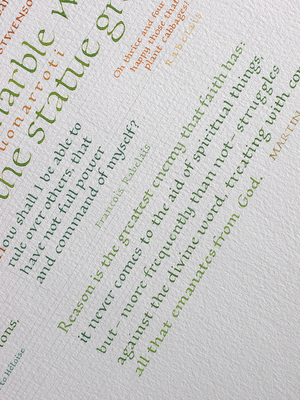 The last class I taught at the Georgia Center at UGA was a Humanist Bookhand class. To inspire the students (I hope!) I did a sampler of quotations, gleaned from Bartlett's. I worked on a a coldpress watercolor paper, which I covered with lines before I began. Then I got busy putting down lettering, with no master plan. Because all the quotes were sort of classical I made sure not to let any overlap for once. And of the three or four colors used I mixed them together some, so overall the quotes related to eachother colorwise. Mostly. Sort of.
The last class I taught at the Georgia Center at UGA was a Humanist Bookhand class. To inspire the students (I hope!) I did a sampler of quotations, gleaned from Bartlett's. I worked on a a coldpress watercolor paper, which I covered with lines before I began. Then I got busy putting down lettering, with no master plan. Because all the quotes were sort of classical I made sure not to let any overlap for once. And of the three or four colors used I mixed them together some, so overall the quotes related to eachother colorwise. Mostly. Sort of.I am still confused about what to call this style of lettering. Some calligraphers--the ones from England mostly--would call this Foundational, which was the hand rediscovered by the famous Edward Johnson, based on his study of the Ramsey Psalter (10th century). However, I've always thought his Foundational hand is more distinctive than my lettering here. His featured an odd g, and on ascenders an unappealing built-up serif. I much prefer no manipulation at all when I write in a humanist bookhand.
My humanist is a distillation of many humanist bookhands--hands (not fonts!) that were used to write books with during a period of time, primarily the 15th century, in Italy. I learned from Steve Skaggs in Italy in the summer of 1987 and from Marsha Brady over three weekend-long classes in the mid-90's. Steve called it Humanistica, or Roman Bookhand.
I cannot bring myself to call mine Foundational, nor can I bring myself to generically refer to all such similar hands as Foundational. Maybe I should just admit that I am not fond of Edward Johnson's Foundational, although he is credited with being the father of modern calligraphy, and I'm glad someone brought it back from the brink of the abyss of forgotten knowledge--if that is indeed where it was.
1 comment:
This is really lovely Margaret. The different shades of green really gives the letters movement.
Post a Comment